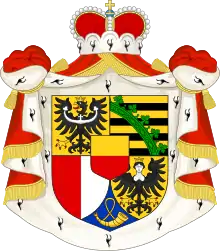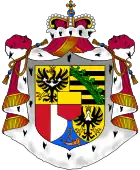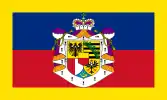Monarchy of Liechtenstein
The Prince Regnant of Liechtenstein (German: Fürst von Liechtenstein) is the monarch and head of state of Liechtenstein.[1] The princely family of Liechtenstein, after which the sovereign principality was named in 1719, hails from Liechtenstein Castle in Lower Austria, which the family possessed from at least 1140 to the thirteenth century, and from 1807 onward. It is the only remaining European monarchy that practises strict agnatic primogeniture, meaning only first-born males may inherit the throne.
| Prince Regnant of Liechtenstein | |
|---|---|
 | |
| Incumbent | |
 | |
| Hans-Adam II since 13 November 1989 | |
| Details | |
| Style | His Serene Highness |
| Heir apparent | Alois |
| First monarch | Karl I |
| Formation | 20 December 1608 |
| Residence | Vaduz Castle |
 |
|---|
| This article is part of a series on the politics and government of Liechtenstein |
History
Through the centuries, the dynasty acquired vast swathes of land, predominantly in Moravia, Lower Austria, Silesia, and Styria, though in all cases, these territories were held in fief under other more senior feudal lords, particularly under various lines of the Habsburg family, to whom several Liechtenstein princes served as close advisors.
Without any territory held immediately from the Imperial crown, the Liechtenstein family, although noble, did not qualify for a seat in the Diet of the Holy Roman Empire. By purchase in 1699 and 1712 from the counts of Waldburg-Zeil-Hohenem of, respectively, the small lordship of Schellenberg and the county of Vaduz, the Liechtensteins acquired immediate lands within the Holy Roman Empire which made them eligible for elevation to the Imperial Diet. Thereby, on 23 January 1719 Emperor Charles VI decreed Vaduz and Schellenberg were henceforth united and raised to the status of a Fürstentum (principality) under the name "Liechtenstein" for "[his] true servant, Anton Florian of Liechtenstein".
Although the family continued to own larger territories in various parts of central and eastern Europe, it was in right of Liechtenstein's status as an Imperial estate that the family of wealthy noble Austrian courtiers became a dynasty of imperial princes, continuing to dwell in the imperial capital of Vienna or on their larger estates elsewhere, not taking up permanent residence in their principality for more than 300 years, moving into their Alpine realm only in 1938, after dissolution of both the Holy Roman Empire and the Austro-Hungarian Empire.
Powers
The prince of Liechtenstein has broad powers, which include the appointment of judges, the dismissal of ministers or government, veto power, and the calling of referendums. The Liechtenstein constitutional referendum, 2003 was a proposal put forth by Prince Hans-Adam II to revise parts of the Constitution of Liechtenstein, on the one hand expanding the monarch's power with the authority to veto legislation, while on the other hand securing for the citizenry the option to abolish the monarchy by vote at any time without being subject to princely veto.[2] The right of the parishes that make up the principality to secede was simultaneously recognised.
Prince Hans-Adam had warned that he and his family would move to Austria if the referendum were rejected. Despite opposition from Mario Frick, a former Liechtenstein prime minister, the referendum was approved by the electorate in 2003. Opponents accused Hans-Adam of engaging in emotional blackmail to achieve his goal and constitutional experts from the Council of Europe branded the event as a retrograde move.[3] A proposal to revoke the prince's new veto powers was rejected by 76% of voters in a 2012 referendum.[4] On 15 August 2004 Prince Hans-Adam II formally delegated most of his sovereign authority to his son and heir, the Hereditary Prince Alois, as a way of transitioning to a new generation. Formally, Hans-Adam remains head of state.[5]
Compensation
The prince does not receive salary, but receives an annual allowance of 250,000 Swiss francs.[6]
Titles
According to their house law,[7] the monarch bears the titles:
- Reigning Prince of Liechtenstein, Duke of Troppau and Jägerndorf, Count of Rietberg, Sovereign of the House of Liechtenstein.
Princely Standard
 Current personal standard of the Prince of Liechtenstein, adopted in 1982.
Current personal standard of the Prince of Liechtenstein, adopted in 1982..svg.png.webp) Personal standard of the Prince of Liechtenstein from 1957 until 1982.
Personal standard of the Prince of Liechtenstein from 1957 until 1982. Former Princely Standard as it appeared in 1912.
Former Princely Standard as it appeared in 1912.
References
- Principality of Liechtenstein Family - Die fürstliche Familie (in German) "Archived copy". Archived from the original on 3 January 2014. Retrieved 13 April 2014.CS1 maint: archived copy as title (link)
- Liechtenstein prince wins powers BBC News Online, 16 March 2003. Retrieved 29 December 2006.
- The Age 18 March 2003. Theage.com.au (18 March 2003).
- "Liechtenstein votes to keep prince's veto". Reuters. 1 July 2012. Retrieved 1 July 2012.
- Country profile: Liechtenstein – Leaders BBC News, 6 December 2006. Retrieved 29 December 2006.
- "Richest royals: what Europe's royal families get from their taxpayers - Business Insider".
- Liechtenstein House Laws Archived 15 June 2012 at the Wayback Machine. Fuerstenhaus.li.
External links
 Media related to Liechtenstein monarchy at Wikimedia Commons
Media related to Liechtenstein monarchy at Wikimedia Commons- The Princely House of Liechtenstein (official site)
